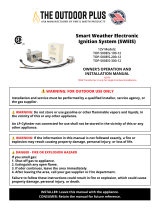POWER VTX
®
WATER HEATER
19
PV500-68 08/2019
8 VENTING
8.1 Venting the POWER VTX
®
:
All POWER VTX® models use the positive pressure generated by the burner system blower to push combustion
products out of the vent. Since the vent system is under positive pressure and must be capable of containing
condensate, it must be constructed of schedule 40 solid PVC or CPVC pipe. Use of cellular core PVC (ASTM F891),
cellular core CPVC, or Radel® (polyphenylsulfone) in nonmetallic venting systems is prohibited. Polypropylene or
single or double wall stainless steel venting listed by ETL, UL, ULC or CSA for Category IV positive pressure gas
appliance venting may be used instead of solid PVC or CPVC plastic pipe venting.
IMPORTANT: If the cold inlet water temperature is above 100°F, then solid CPVC or ETL, UL, ULC or CSA listed
polypropylene or stainless steel venting is required and the vent limit switch must be adjusted for the higher
temperature rating allowed by these vent materials. (See Section 10.6 – Changing the Vent Material Type.)
Utilisez une catégorie IV PVC, CPVC ou ETL, UL, ULC ou CSA acier inoxydable ou inscrits conduit d'évacuation en
polypropylène. Ne sélectionnez pas la taille du tuyau de ventilation basée uniquement sur le diamètre raccord de
l'appareil.
Follow the instructions below for installing solid PVC or CPVC pipe. For other listed vent materials, follow the vent
manufacturer’s instructions for installation, sealing, supporting and terminating their vent system. Covering non‐metallic
vent pipe and fittings with thermal insulation is prohibited.
The stainless steel vent connection located near the back of the water heater is 6-5/8″ O.D., to accept a 6 inch PVC
or CPVC pipe coupling. A reducer coupling may also be used to accommodate smaller or larger vent pipe. (See
Maximum Vent Length tables). Do not use a barometric damper with the POWER VTX® positive pressure vent.
The POWER VTX® water heater can be vented either vertically, through a ceiling or roof, or horizontally through a wall.
The POWER VTX® is a Category IV positive pressure gas appliance and venting can be routed to the outdoors in any
direction, from the flue outlet of the water heater, except down. The vent must be installed and supported at least every
four feet to slope downward toward the water heater vent connection with at least ¼ inch drop per linear foot of
horizontal vent run, to allow proper drainage of accumulated condensation. The venting system will also have means
for collection and disposal of condensate. All penetrations through walls and roofs must be weather and gas tight, such
that rain and products of combustion cannot pass from outdoors back indoors.
Additional steps required when venting with solid PVC or CPVC pipe:
1. Read and follow the information, instructions and warnings in “VENTING” section.
2. Do not insulate the plastic vent pipe.
3. Design the vent pipe route so that normal expansion (pipe getting longer) and contraction (pipe getting shorter),
due to on and off temperatures, does not bind or put stress on cemented pipe fittings.
4. A 6-inch pipe coupling must always be the first fitting attached to the POWER VTX® vent connection when using
a PVC or CPVC vent system. If a listed stainless steel or polypropylene Category IV vent system is used, the
correct adapter for attaching and sealing to the POWER VTX® 6-5/8 inch O.D. vent connection must be obtained
from the manufacturer of the vent system to be installed.
5. For PVC or CPVC, dry-fit the 6” pipe coupling onto the POWER VTX® vent connector. Then remove the coupling
and apply a liberal coating of room temperature vulcanizing (RTV) adhesive to the outside of the vent connector
and to the inside of the plastic pipe coupling. Before the RTV sets, slide the coupling over the vent connector
while rotating approximately 1/8 of a turn. Inspect and apply additional RTV to the joints, if needed to provide an
air and water tight seal.
6. Drill a pilot hole through the PVC or CPVC coupling flange and into the center of the stainless steel vent connector
flange in three equally spaced locations around the pipe. Drive stainless steel sheet metal screws through the
pilot holes to attach and firmly hold the plastic coupling onto the vent connector flange.
7. Clean and deburr all solid PVC or CPVC pipe ends, then trial assemble the entire vent system vent before joining
with cement. Mark the pipe and fittings to identify their locations, then disassemble. Reassemble the vent system
using fresh PVC cement to connect PVC pipe and fresh CPVC cement to connect CPVC pipe. If both solid PVC
and solid CPVC pipe are used in the same vent system, all joints between the two types of pipe must be made
with fresh cement suitable for both materials. Follow the cement manufacturer’s instructions for making sound air
and water tight joints.
8. Vent support – For PVC or CPVC, the vent system must be supported at intervals no greater than four feet, to
prevent sagging, distortion and stress on pipe fittings. Vertical pipe must also be supported to avoid stress on all
cemented pipe fittings and to prevent putting excessive weight on the appliance vent connection. For listed
stainless steel or polypropylene vent system, follow the vent system manufacturer’s instructions.





















